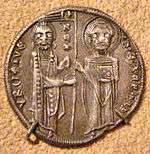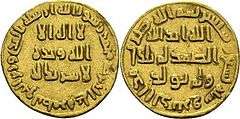Dinar
The dinar (/dɪˈnɑːr/) is the principal currency unit in several countries near the Mediterranean Sea, and its historical use is even more widespread.
| Look up dinar in Wiktionary, the free dictionary. |

The modern dinar's historical antecedents are the gold dinar, the main coin of the medieval Islamic empires, first issued in AH 77 (696–697 CE) by Caliph Abd al-Malik ibn Marwan. The word "dinar" derives from the silver "denarius" coin of ancient Rome, first minted about 211 BCE.

The English word "dinar" is the transliteration of the Arabic دينار (dīnār), which was borrowed via the Syriac dīnarā from the Greek δηνάριον (dēnárion), itself from the Latin dēnārius.[1][2]
The Kushan Empire introduced a gold coin known as the dīnāra into India in the 1st century AD; the Gupta Empire and its successors up to the 6th century adopted the coin.[3][4] The modern gold dinar is a projected bullion gold coin, as of 2019 not issued as official currency by any state.
Legal tender
Countries currently using a currency called "dinar" or similar

| Countries | Currency | ISO 4217 code |
|---|---|---|
| Algerian dinar | DZD | |
| Bahraini dinar | BHD | |
| Iraqi dinar | IQD | |
| Jordanian dinar | JOD | |
| Kuwaiti dinar | KWD | |
| Libyan dinar | LYD | |
| Macedonian denar | MKN (1992–1993) MKD (1993− ) | |
| Serbian dinar | RSD CSD (2003-2006) | |
| Tunisian dinar | TND |
Countries and regions which have previously used a currency called "dinar" in the 20th century

| Countries | Currency | ISO 4217 code | Used | Replaced by |
|---|---|---|---|---|
| Bahraini dinar | BHD | 1966–1973 | United Arab Emirates Dirham | |
| Bosnia and Herzegovina dinar | BAD | 1992–1998 | Bosnia and Herzegovina convertible mark | |
| Croatian dinar | HRD | 1991–1994 | Croatian kuna | |
| Iranian rial was divided into at first 1250 and then 100 dinars | ||||
| South Yemeni dinar | YDD | 1965–1990 | Yemeni rial | |
| Sudanese dinar | SDD | 1992–2007 | Sudanese pound | |
| Yugoslav dinar | YUD (1965–1989) YUN (1990–1992) YUR (1992–1993) YUO (1993) YUG (1994) YUM (1994–2003) | 1918–2003 | n/a | |
The 8th century English king Offa of Mercia minted copies of Abbasid dinars struck in 774 by Caliph Al-Mansur with "Offa Rex" centered on the reverse.[5][6] The moneyer visibly had no understanding of Arabic as the Arabic text contains many errors. Such coins may have been produced for trade with Islamic Spain.
See also
References
- Oxford English Dictionary, Second edition, 1989, s.v. "dinar"; online version November 2010
- Versteegh, C. H. M.; Versteegh, Kees (2001). The Arabic Language. Edinburgh University Press. p. 60. ISBN 978-0-7486-1436-3.
- Friedberg, Arthur L.; Friedberg, Ira S. (2009). Gold Coins of the World: From Ancient Times to the Present. Coin & Currency Institute. p. 457. ISBN 978-0-87184-308-1.
- Mookerji, Radhakumud (2007). The Gupta Empire. Motilal Banarsidass. pp. 30–31. ISBN 978-81-208-0440-1.
- https://www.britishmuseum.org/research/collection_online/collection_object_details.aspx?assetId=31108001&objectId=1093298&partId=1
- Medieval European Coinage by Philip Grierson, p. 330.
External links
| Wikimedia Commons has media related to Dinar. |
| Look up dinero in Wiktionary, the free dictionary. |
- Krause, Chester L.; Clifford Mishler (2003). 2004 Standard Catalog of World Coins: 1901–Present. Colin R. Bruce II (senior editor) (31st ed.). Krause Publications. ISBN 0873495934.
- Malaysia: Kelantan collects Zakat in Shariah money